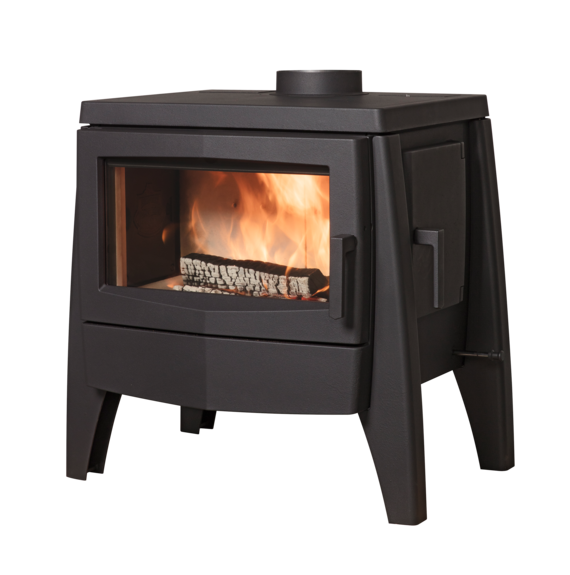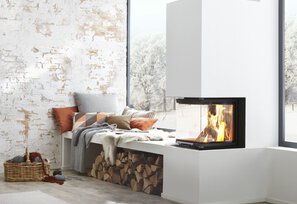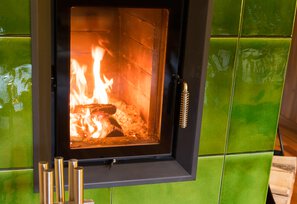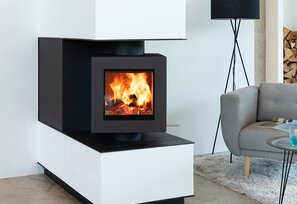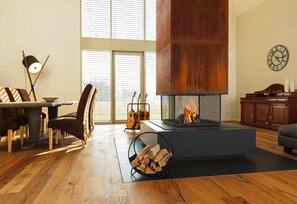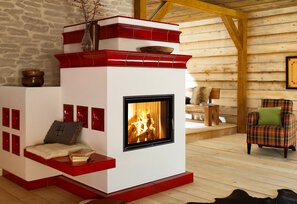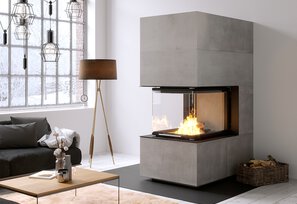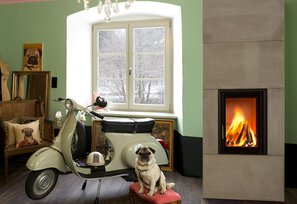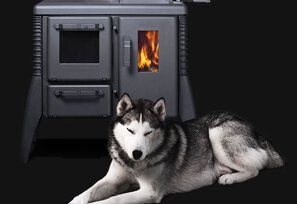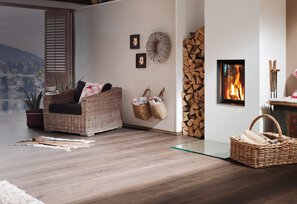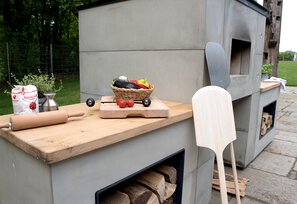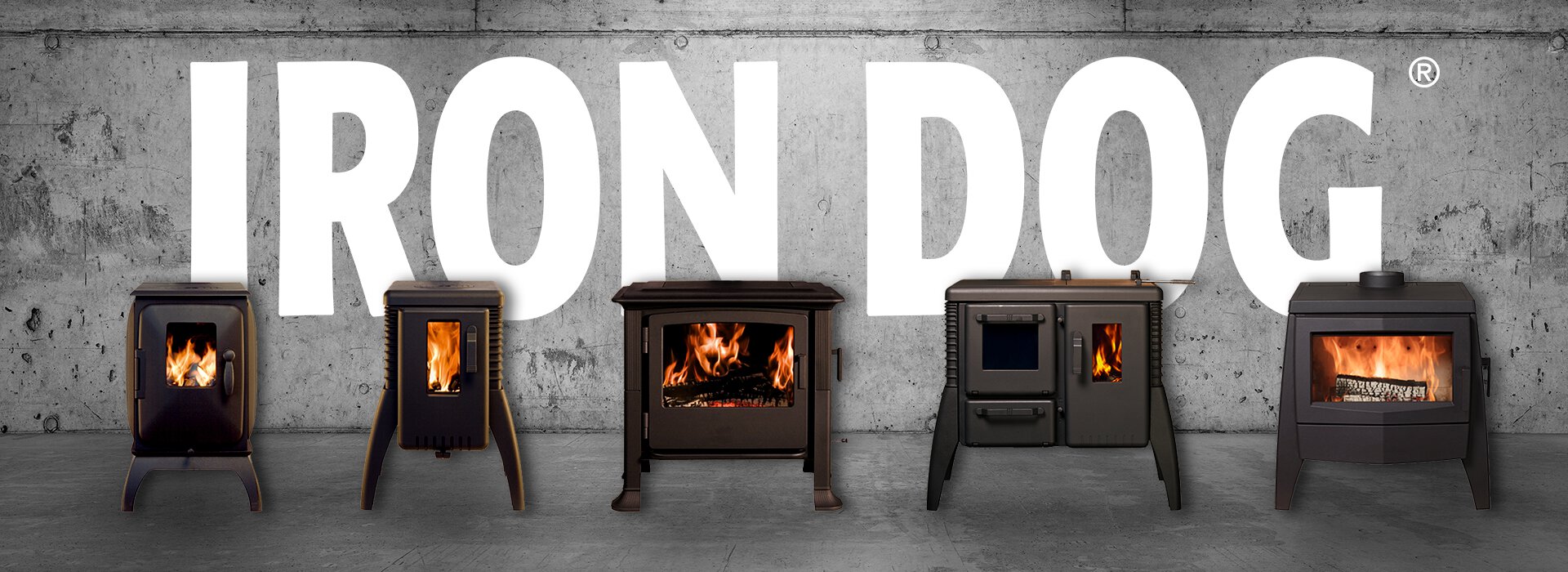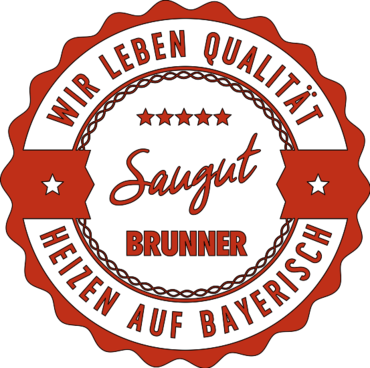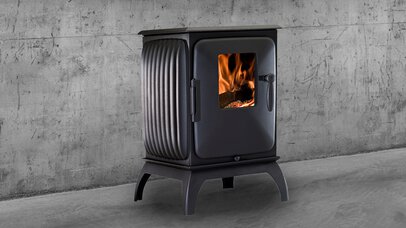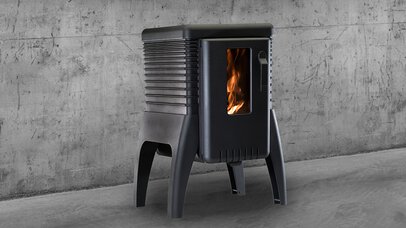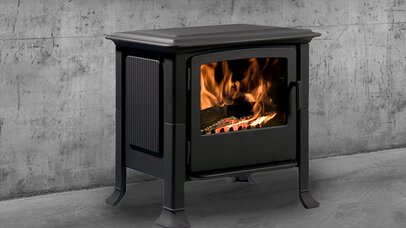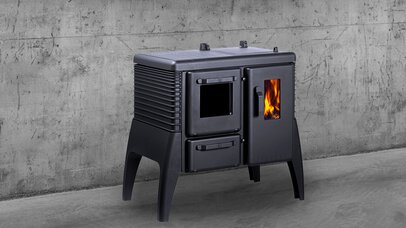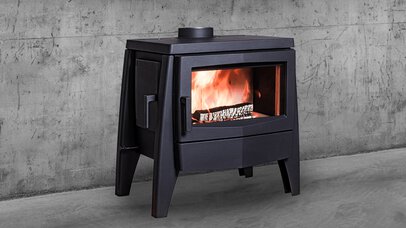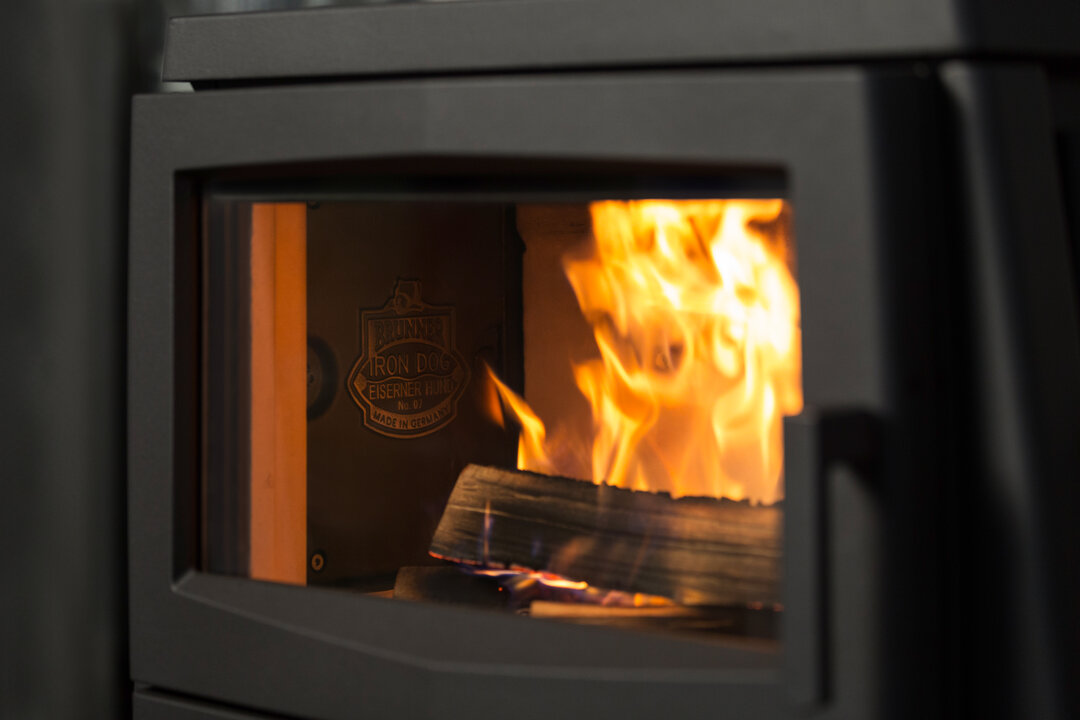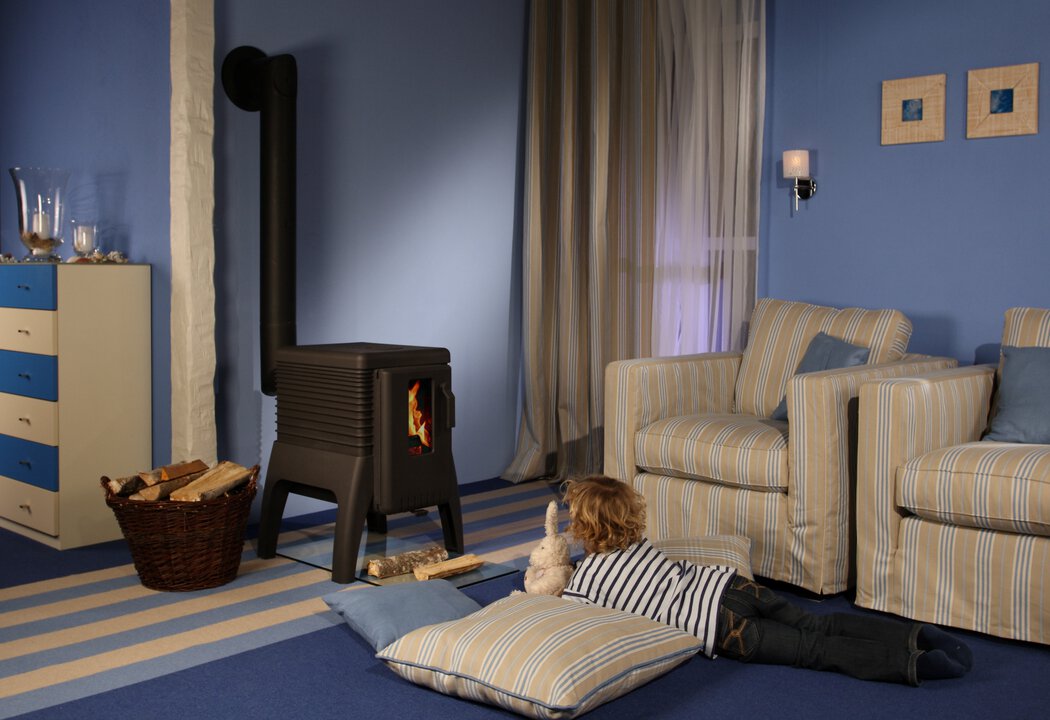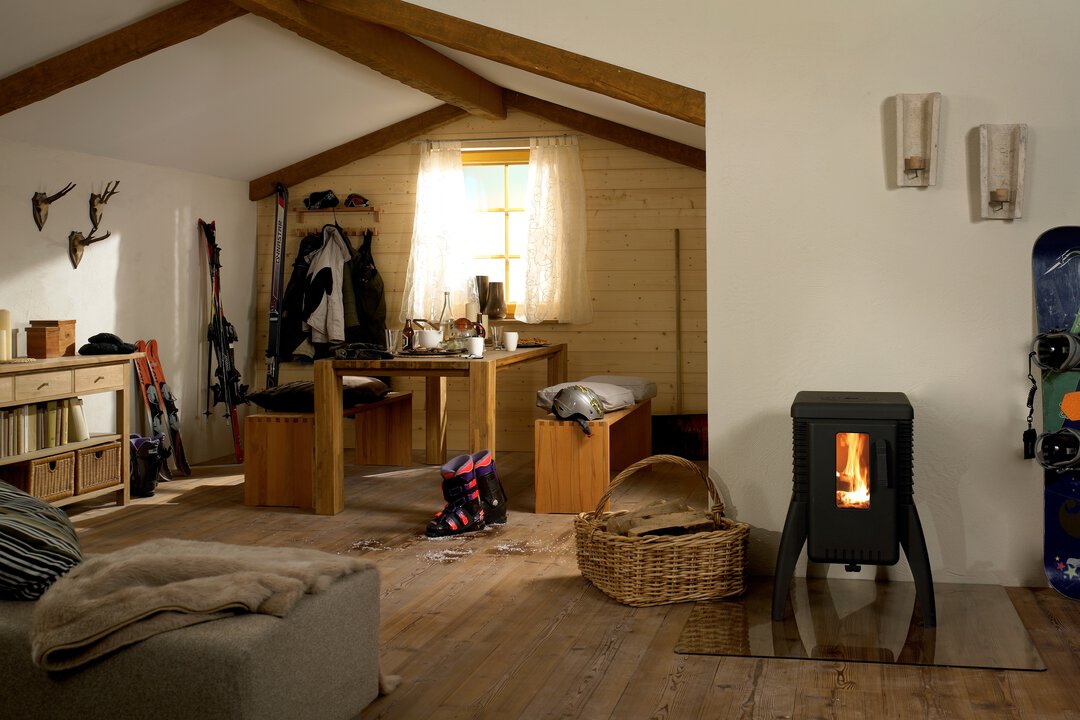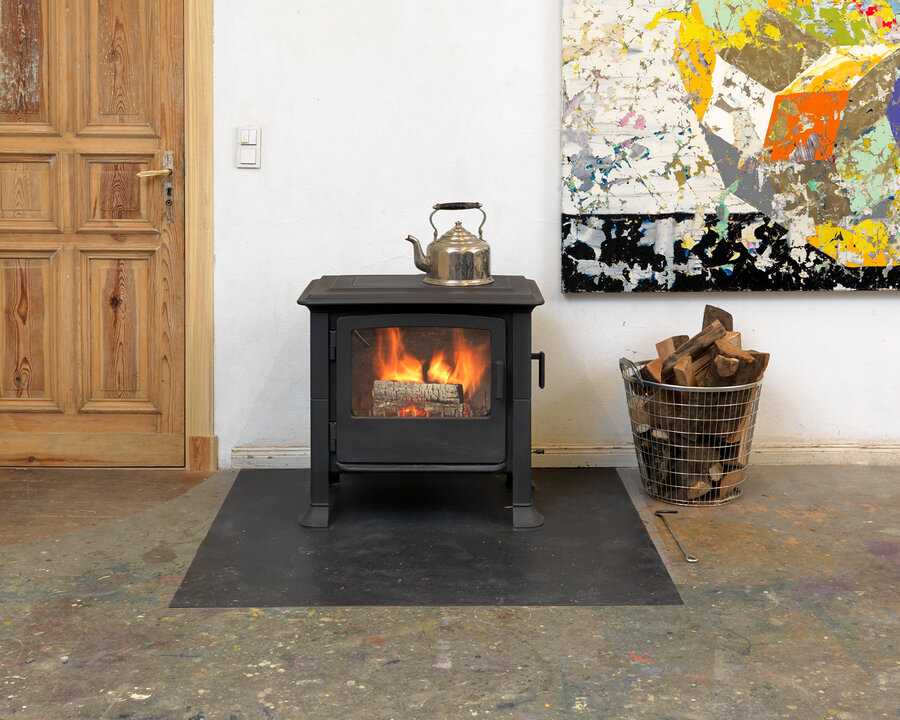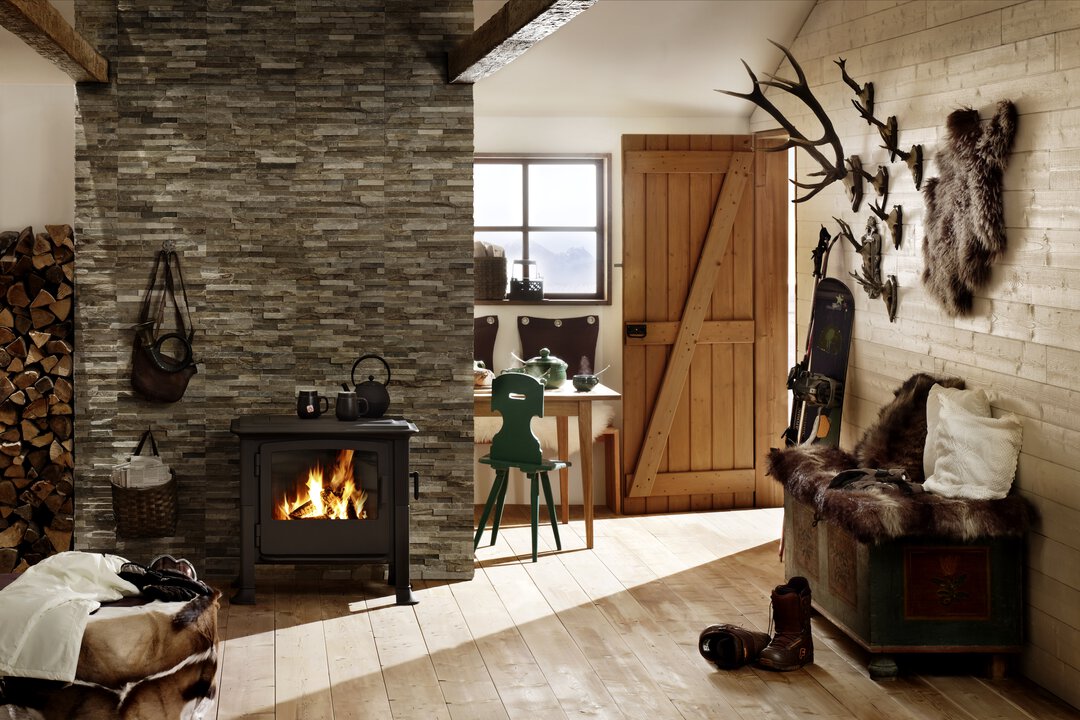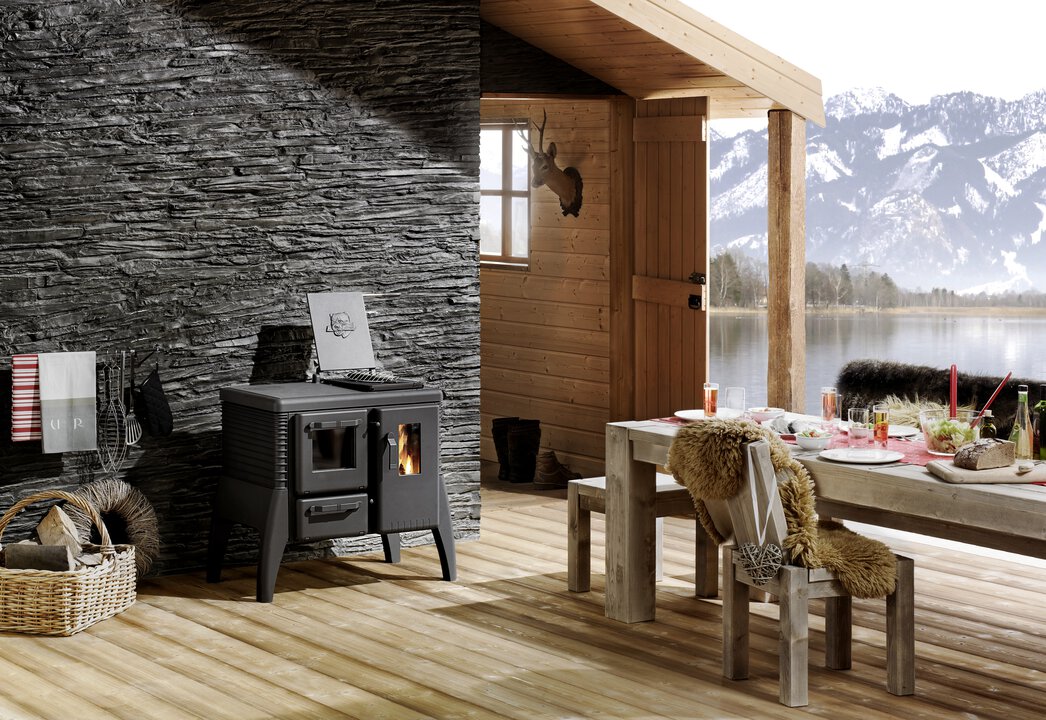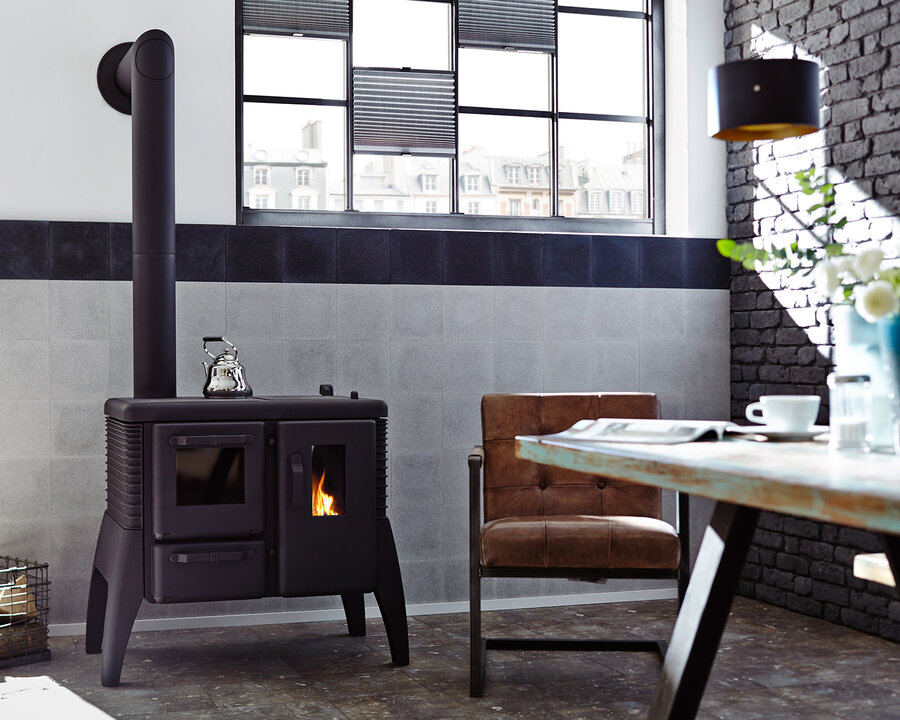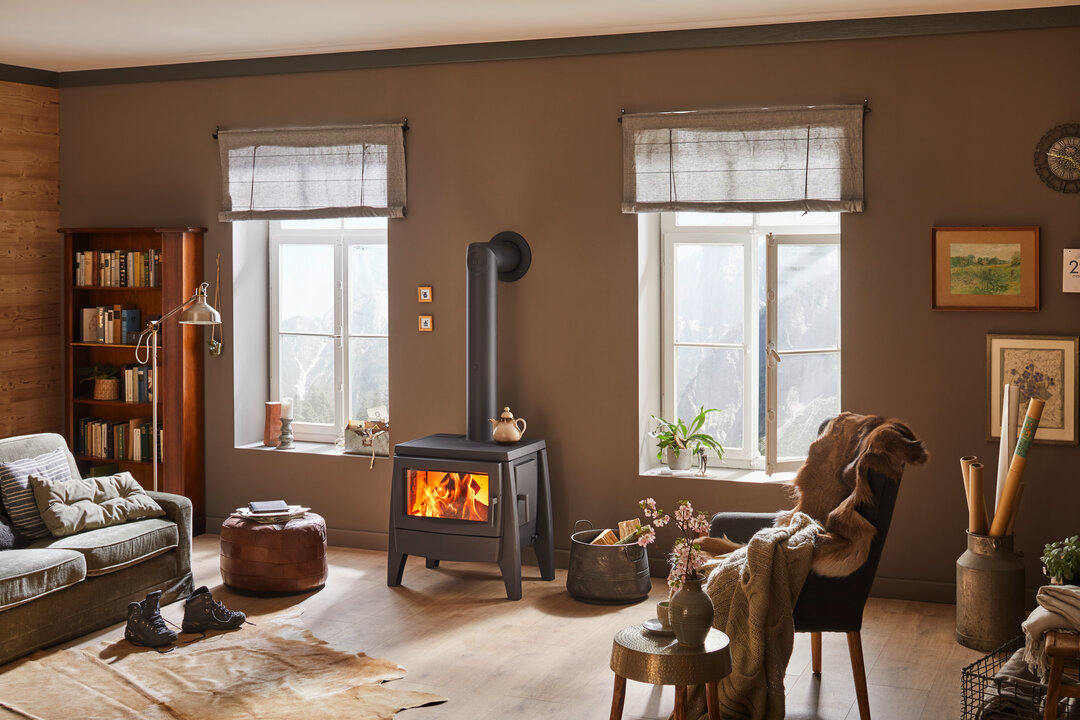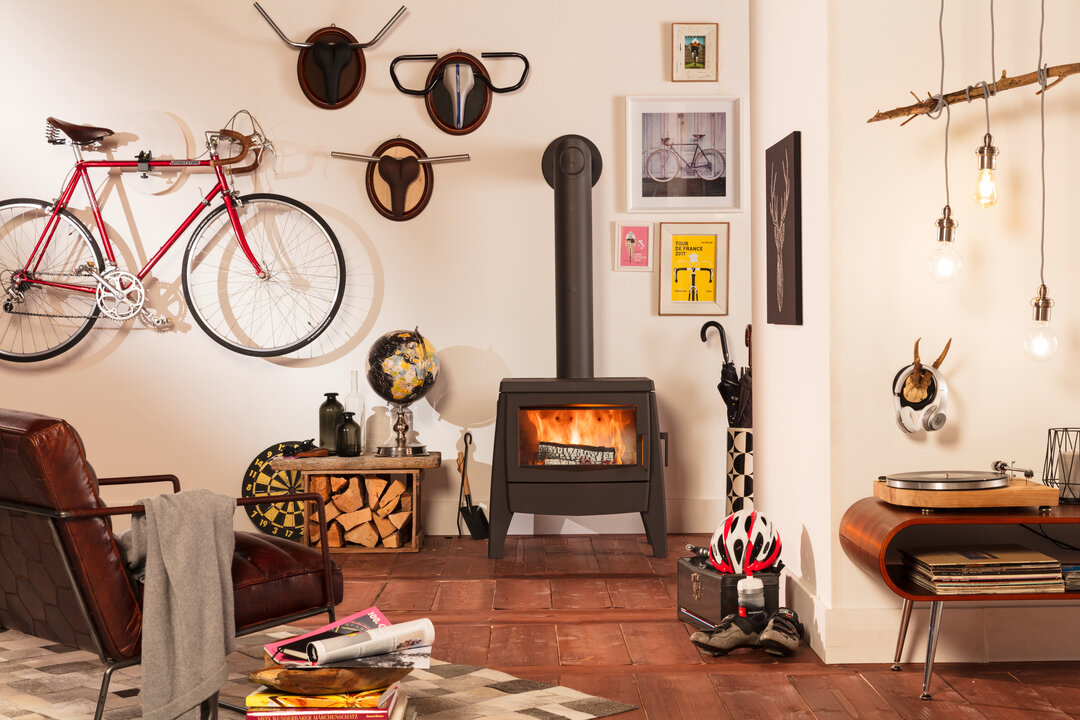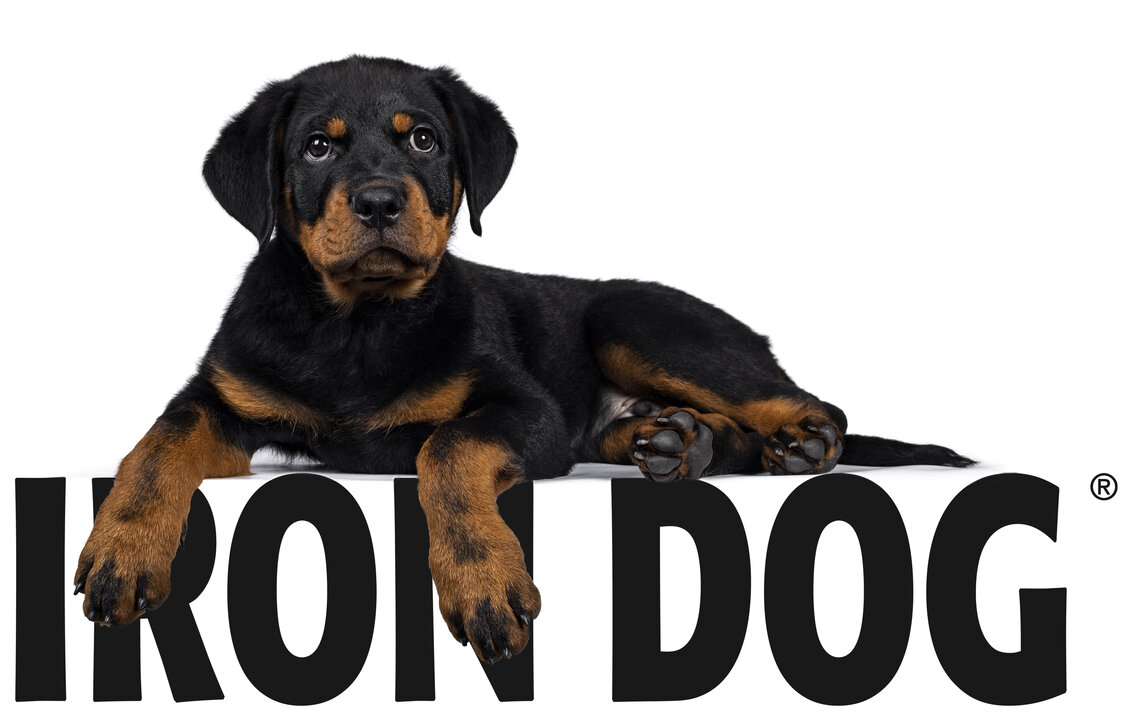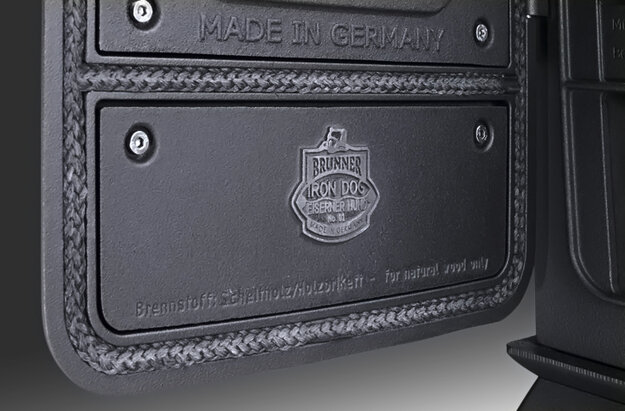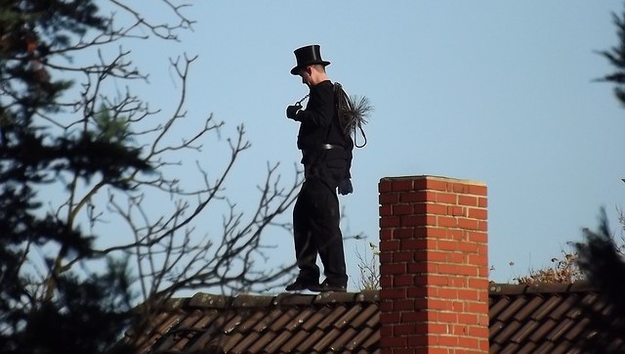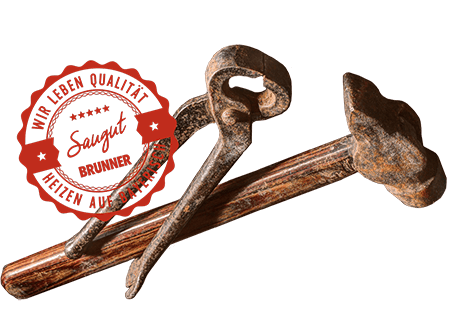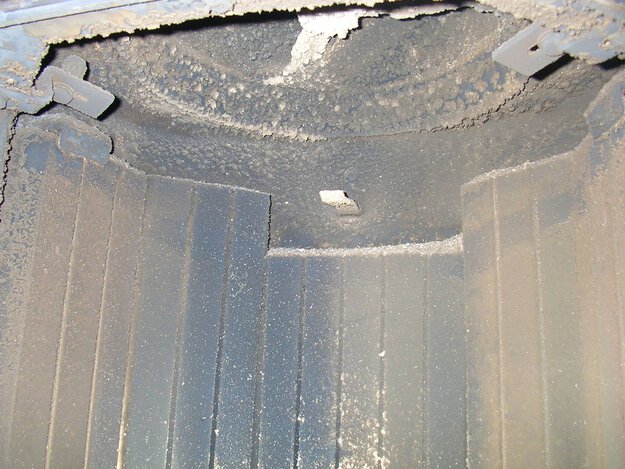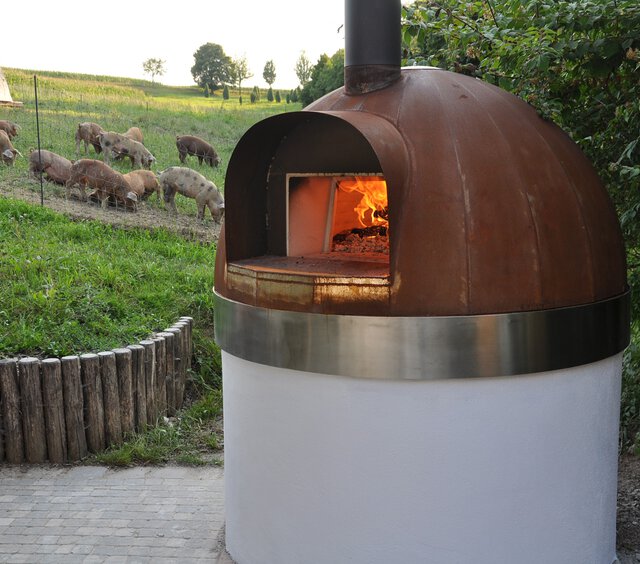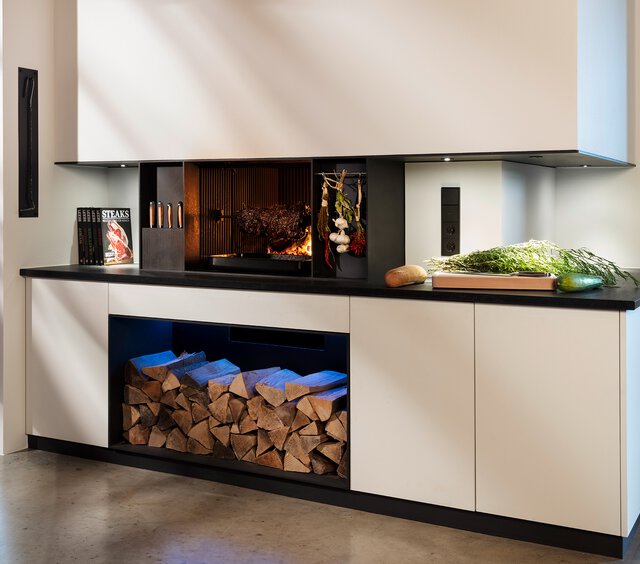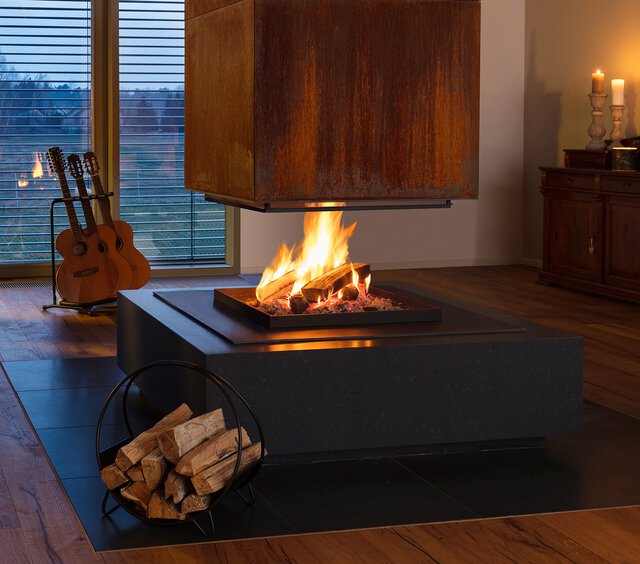IRON DOG®
Cast-iron wood stoves - made in Germany
A faithful companion for cold days
If you are looking for a special kind of Swedish stove, you will find it in the IRON DOGs® by BRUNNER. Timeless in design, the series of durable cast iron stoves suits any interior style. IRON DOGs® stand for the highest quality and are made entirely of cast iron in Germany. And last but not least, IRON DOGs® are a matter of the heart for us, into which we have put all our skill and all our enthusiasm for the special. That's why you can cook with every IRON DOG®. All models have a hotplate - and one of them even has an oven and grill function. Get to know the special stoves: in the showroom of your IRON DOG® partner or the IRON DOG® Infopoint near you.
Primarily heat
Of course, some devices offer a larger glass-ceramic format for more fire visibility, but with the IRON DOG® series stove, the focus is clearly on the heat.
A wood stove makes pleasant radiant heat
You simply feel good in a warm room. But this feeling of well-being is not only due to the temperature. The room climate is decisive. Above all, radiant heat - in contrast to convection heat - is perceived as very pleasant. It works in a similar way to the rays of the sun. They move through the room and hit solid or liquid objects, which absorb the rays and become heated from the inside. Radiant heat actually gets under people's skin. With convection heat, on the contrary, people feel very comfortable. is only conveyed to somewhere else.
The IRON DOG® cast-iron stove
Why "Iron Dog”
A cast-iron stove not only creates a pleasant warmth - it is also a real eye-catcher in any living space and radiates special cosiness. The cast-iron stoves by Ulrich Brunner GmbH are manufactured in Bavaria and are made entirely from one source: from development and production to inspection and assembly of the so-called Swedish stoves. The cast-iron stoves from the Iron Dog series differ from each other in many ways, for example in size, material and function.
Some stoves accompany you through the winter - this one through the whole life
An Iron Dog accompanies its owners throughout their lives: It burns for them and makes four walls a warm home with its warm disposition. It is as reliable and loyal as a good friend. And at the same time as versatile and special as the people it was made for.
A dog is loyal, loves being close to people and is happy when it comes home - hence the name "dog". And iron, because the IRON DOG® is made of 7 millimetre (0.27 inches) thick cast iron. The "iron dog" lasts longer than a human lifetime and at least 100 years. It is a designer stove, for people with high demands on form and quality. It spreads cosy warmth and a wonderfully comfortable atmosphere. Thanks to the hotplate, baking compartment* and grill grate*, it is also suitable for cooking - and all this with the CO2-neutral energy source wood.
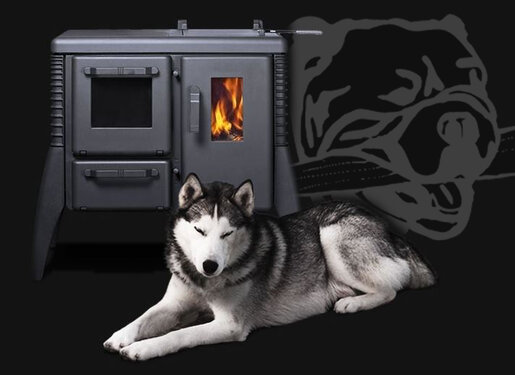
Wood stoves made from cast-iron
Cast iron stoves are made from one of the highest quality materials
The IRON DOG® is made of 100 percent cast-iron, made in Germany. Cast-iron is one of the highest quality materials, it has the highest thermal conductivity, it is durable and extremely robust and meets strict health and environmental requirements. Due to its low thermal expansion, cast-iron does not deform. With a weight of 130 to 300 kilograms (depending on the model), the IRON DOG® is not light, but it has a safe stand during all operations - even when cooking.
What is cast-iron?
Cast-iron consists of iron ore and belongs to the iron materials. With a carbon content of more than two percent, it has a much higher carbon content than steel and a significantly lower melting point of around 1150 degrees Celsius (2102 degrees Fahrenheit). Due to its high carbon content, cast-iron is very hard and brittle and cannot be forged, shaped, bent or rolled. The shaping of cast-iron is done by casting, the fine machining by turning, drilling and milling, which is summarised under the term "machining".
A distinction is made between white cast-iron, which is formed when the melt cools down quickly and is largely made of cementite, and grey cast-iron. In grey cast-iron, the carbon is not bound in cementite, but is present as graphite. Grey cast-iron is formed by very slow cooling. The most commonly used cast-iron material is lamellar graphite cast-iron.
And this is how the technology behind it works
An ingenious combustion air supply system ensures slow and even degassing of the logs, with the lowest possible emissions or combustion residues. The degassing is gently driven by the primary air flowing directly into the ember trough. The secondary air keeps the glazing clean. It also mixes the combustion gases with the necessary oxygen in front of the flame channel, and the tertiary air promptly mixes the gases escaping in the rear area of the combustion chamber and causes them to ignite. The IRON DOG® is operated very simply with a single control element. Its high efficiency is achieved by large heat absorption surfaces in combination with special heating gas deflectors. For combustion with black fuel such as coal or peat, the "iron dog" is also available in the multi-fuel version with a different combustion grate device. The most important technical data (depending on the model) at a glance:
- The nominal heating capacity is between 7 and 8 kilowatts
- The consumption/h is between 2 and 2.5 kilograms
- The room heating capacity is between 50-90 and 60-110 square metres
- The dimensions respectively (h x w x d) are between 680x440x630 (26.7x17.3x24.8 inches) and 810x940x625 millimetres (31.8x37.3x24.6 inches)
- The firebox opening (h x w) is between 200x245 and 265x295 millimetres (7.87x9.64. and 10.43x11.61 inches)
*only for IRON DOG® 06
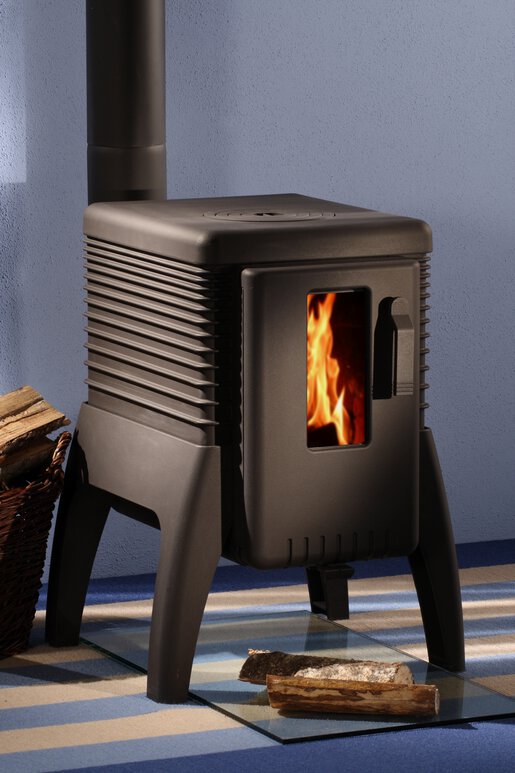
Wood stoves are an excellent investment
And good for the environment
People who do not own their own house or flat do not want to do without the cosy atmosphere of a fireplace. For them, a wood stove is the ideal solution. The advantage: A hand-built fireplace or stove costs several thousand euros and is permanently installed. Fireplace and room stoves can be dismantled at any time and reassembled elsewhere when moving house. This is especially beneficial for tenants and younger people, because they do not have to invest unnecessarily in someone else's house or rented flat. So if you want to save money on an elaborate fireplace or storage heater, choose a wood stove. The stand-alone room stoves are cheaper and offer just as much comfort and pleasant warmth.
A wood fire is not only a particularly pleasant source of heat, anyone who heats with wood is also doing something for the environment. In Germany, more wood grows every day than is mined. Wood protects the environment and conserves resources. Heating with wood stoves, fireplaces or tiled stoves is almost CO2-neutral, the natural energy source used is renewable and right on your doorstep. In contrast to gas or oil, less sulphur dioxide is produced and the transport distances for wood are very short, as it grows in local forests. Wood is not subject to large price fluctuations and is independent of political events or other external factors.
However, heating with wood is only environment-friendly if the stove is handled correctly. Sufficient air supply must always be ensured and only dry and untreated firewood may be used. After all, everything you heat in the wood stove will soon be found in your own garden and in nature. Rubbish does not belong in any stove.
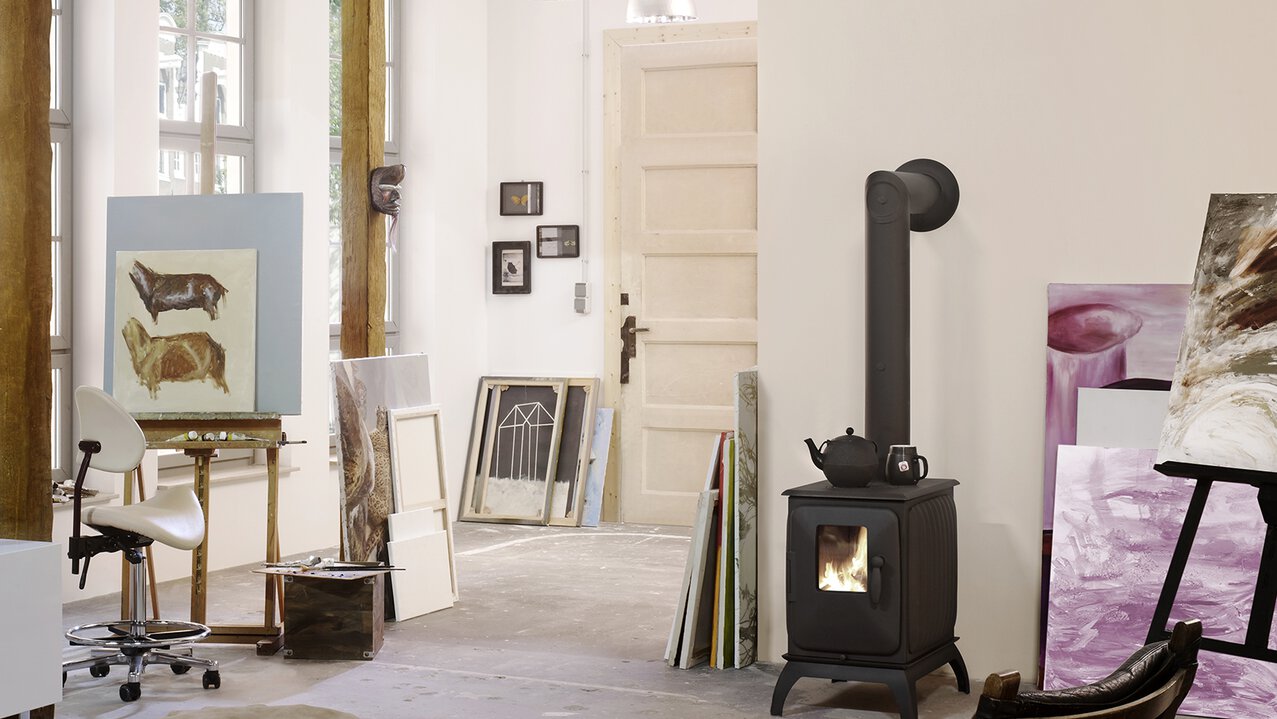
Swedish stove or wood stove
There are various models to buy in different designs, in cast iron, as a steel stove, with a cladding of soapstone, natural stone or ceramic. A wood stove is often called a Swedish stove. It is placed in the installation room next to the chimney, connected to a stove pipe, put into operation and must be checked regularly by a chimney sweep. Unlike an open fireplace, the combustion chamber is closed, there are only air inlet openings. The fuels for a wood stove are pellets or logs. A practical feature is a wood compartment, which is often integrated in a wood stove or can be added later.
Very heat-resistant ceramic glass is used for the windows in the doors of the wood stove. It can withstand temperatures of up to 700 degrees Celsius (1292 degrees Fahrenheit). A stove gives off heat in the form of radiation and convection heat. In contrast, masonry or storage heaters heat the room only through radiant heat. One advantage of wood stoves: they heat quickly and effectively, for cosy hours in front of a comfortable fire. However, there is a risk that the room in which they are installed will get too hot.
When buying a new wood stove, you should pay attention to a high degree of efficiency and low emissions, this saves energy and possible higher purchase costs are compensated for by lower fuel requirements.
Cast-iron wood stove: antique or modern?
In the 14th century, iron casting appeared. At that time it was mainly used for making cannonballs and then increasingly as a material for a cast-iron wood stove to heat with. A cast-iron stove is therefore something of a classic among stoves. It is often called a Swedish stove, sometimes also a workshop stove. It is usually fired with wood and heats in an environment-friendly and sustainable way. Unlike an open fireplace, its combustion chamber is closed and lined with fireclay. A wood stove is usually not permanently installed like a tiled stove, for example, and can also be retrofitted in the house or flat.
The style and technology of cast-iron wood stoves have always adapted to their time over the last 600 years. Sometimes baroque ornate cast-iron stoves with cast-iron doors were in fashion, sometimes the sweeping Art Nouveau style.
Cast-iron stoves have a solid, very tactile look. Nowadays they come in many different designs and sizes, round, rectangular or pyramid-shaped, as pillar or oval stoves, classic or modern. Classic cast-iron stoves bring nostalgia and a vintage look into the home. The appliances are usually smaller, have a gentle shape and their flue is visible. Modern cast-iron stoves are characterised by a minimalist aesthetic. Units with a clear industrial look fit perfectly into simply furnished rooms. Regardless of the style, today's devices are technically state-of-the-art and meet the legal requirements around emission values and environmental protection.
Everything from one source
The Lower Bavarian premium manufacturer BRUNNER uses only high-quality materials, 100% made in Germany. Every product is checked for perfection, so it can be guaranteed that only the highest and flawless quality leaves the warehouse. It has also proven itself that everything is made in-house, starting with the design by our own engineers and technicians, continuing with a prototype in the test laboratory and with series production in our own foundry. Assembly and inspection are the last steps before an IRON DOG® goes on sale.
Our understanding of craftsmanship
We leave nothing out of hand from start to finish. Because only those who know the whole can stand behind it with pride and conviction. This is how we guarantee quality down to the smallest detail. This begins with the design by our own engineers and technicians, continues with a prototype in our test laboratory as well as the production in our foundry and extends to the inspection and assembly of an IRON DOG® - and far beyond. Because even if there is something to improve, we are happy to do it immediately.
That's why there is a specification sheet for this project too
This means that a product is developed with a professional approach. Clear goals and tasks lead to results without surprises. In three years of preparation and development, the "Iron Dogs" were created this way.
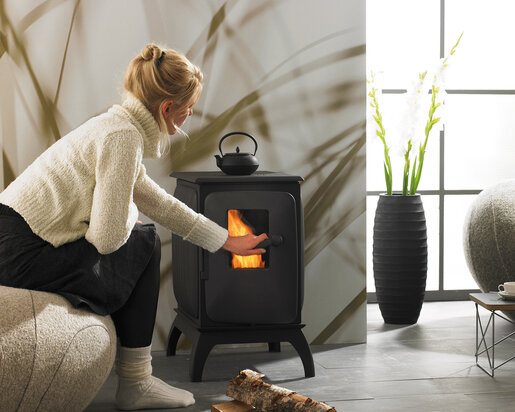
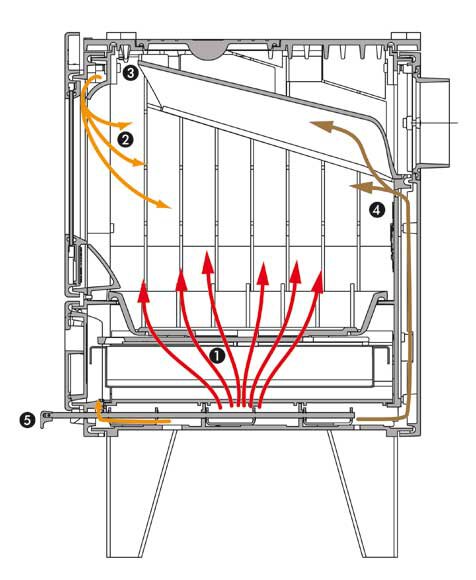
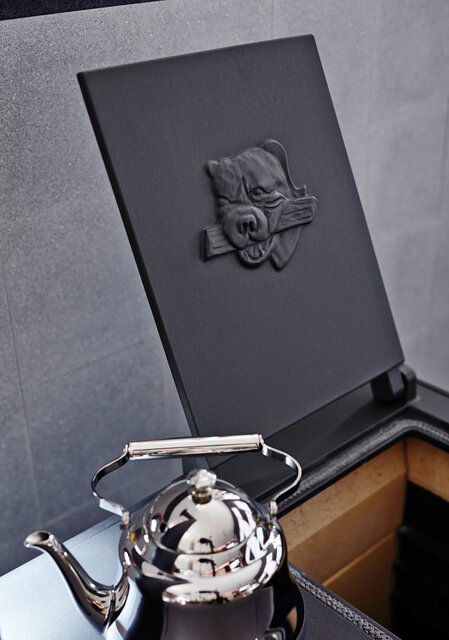
The technology
Ingenious combustion air supply system
An ingenious supply of combustion air ensures slow and even degassing of the logs with the lowest emissions or combustion residues. The primary air (1) flows directly into the ember trough and gently drives the degassing. The secondary air (2) keeps the viewing glass clean and mixes the combustion gases with the necessary oxygen in front of the flame channel (3). The tertiary air (4) mixes the gases escaping in the rear area of the combustion chamber promptly and causes them to ignite. The stove is operated with a single control element (5). There is no simpler way to operate a wood stove. The high efficiency is achieved by large heat absorption surfaces in combination with special heating gas deflectors.
| Product | Wood stove |
| Fuel | Wood |
| Design | Optical advancement by the designer |
| Naming | Expressive, concise, unique, international |
| Material | Cast-iron 7 mm |
| Construction | Tight screw connection, Stainless steel jointing |
| Special feature | Compliant shape, easy operation, low emissions |
| Place of manufacture | Germany |
| Target group | People with a demand for form and quality |
| Lifetime | It will probably outlive you - a nice heirloom ; -) |
The material
Resistant even in the greatest heat
Cast- iron is almost twice as thick as sheet steel - which is usually used for stoves - which explains its longer heat retention. The distribution of the heat is also better, it feels cosy, because a cast-iron wood stove spreads cosy radiant heat, which is comparable to the radiation of the sun. When the rays in the infrared range hit a solid object, it begins to vibrate faster, heats up and in turn gives off this energy as heat. Radiant heat is perceived by people as very pleasant, as if they were being warmed from the inside. At the same time, the air humidity does not change and there is no dust or air turbulence with radiant heat, which not only pleases allergy sufferers. Another advantage: the heat in the room is perceived to be higher than it actually is, by up to two degrees Celsius (35.6 degrees Fahrenheit). With a cast-iron wood stove, therefore, you get a high degree of efficiency with low wood consumption or other fuel at the same time. There are also systems for brown or hard coal. This has the highest heat output, but is also considerably more expensive. The logs should ideally be made of hardwood such as beech, oak or alder.
Room-air-independent wood stove, what does that mean?
Every fire needs oxygen to burn. Stoves get this oxygen either from the room where they are installed or from the outside; accordingly, they are room-air-dependent or room-air-independent systems.
- A room-air-dependent stove draws the combustion air from the room in which it is located. This is quite feasible, especially in older houses with low insulation, because oxygen gets inside through cracks and windows; an outside air connection is not necessary. But care must be taken to ventilate the room regularly once the wood stove is burning.
- A room sealed wood stove works with an external combustion air supply. The air is supplied to the appliance via an outside air connection, which must be approved by the German Institute for Building Technology (DIBt). A room-air-independent stove is usually installed in modern passive and low-energy houses. A ventilation system in the house also requires a room-air-independent stove for safety reasons. Room-air-independent devices are logically not available for open fireplaces because they do not have a closed combustion chamber.
Water-bearing wood stove, what does that mean?
Sitting in front of the wood stove, watching the flames play and enjoying the warmth - for many flat or house owners, these are important reasons for buying a fireplace. But there are devices that can do even more. Water-bearing systems also supply the house's hot water and heating system with heat. They pay off especially in the transitional periods, i.e. in spring and autumn. With two burn-offs per day, they support the heating system, so the main heating does not even have to come on. In addition, a water-bearing stove protects the environment, because the fuel wood is CO2-neutral. How does a water-bearing wood stove work? It only transfers part of the heat from the combustion process to the room where it is installed. The other part of the heat is stored in a buffer tank. From there it is fed into the central heating system.
Wood stove with baking compartment and hotplate
So there are stoves for heating, there are water-bearing devices and there are stoves that you can even cook with. Just like in grandmother's day. These stoves have an oven compartment, a hotplate and sometimes a grill. While you use them to conjure up the most delicious dishes, the room naturally also gets toasty warm. Wood-burning kitchen cookers used to be quite common and are now increasingly popular again. Not only because of their heating power and because they visually enhance any kitchen space, but also because food prepared in a wood oven simply tastes so much more aromatic. While the cake is deliciously fluffy and juicy in the oven compartment or the stew is slowly simmering away on the hob, the wood compartment only needs to be refilled occasionally.
The IRON DOG® 06 by BRUNNER not only impresses with its purist design, after burn-off it can even be used for excellent grilling over the embers. Your barbecue is done in the wood stove. But you don't have to be afraid of odours in closed rooms, they are immediately discharged into the open air through the chimney.
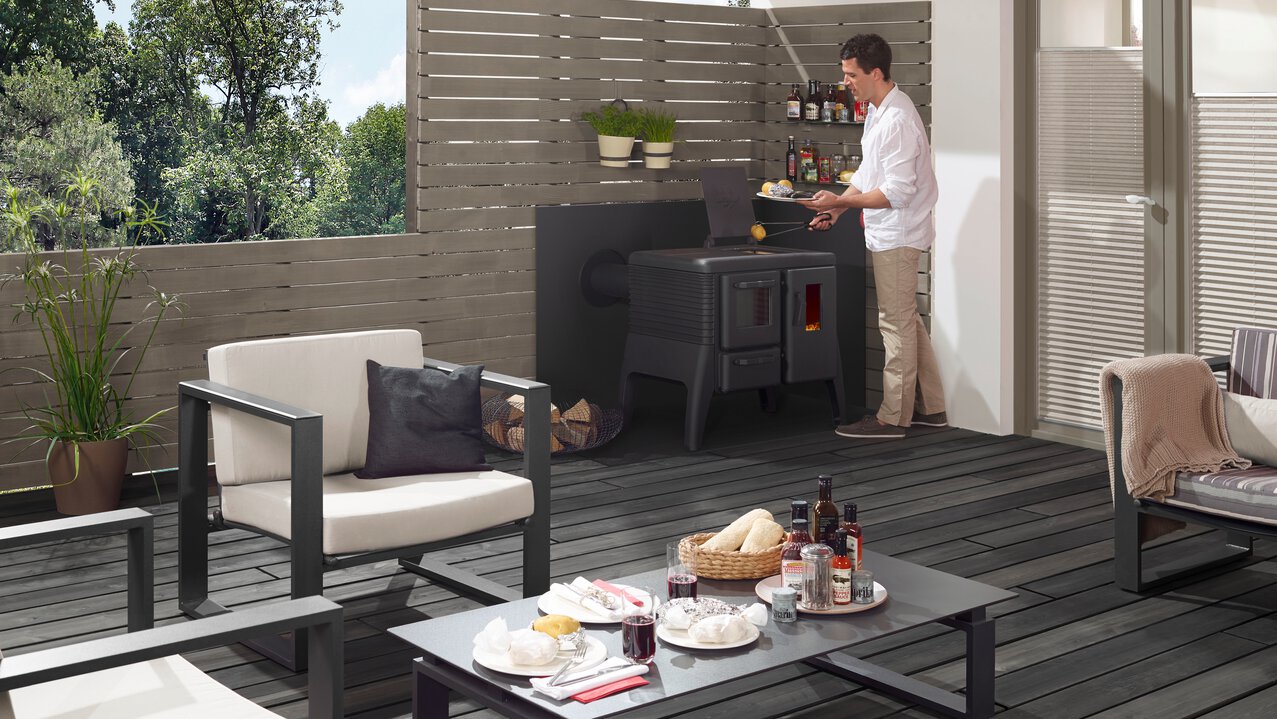
The Guarantee
So that you can enjoy it for a long time
We grant a 10-year guarantee for all IRON DOG® cast-iron stoves. This covers the cast parts used and their industrial manufacture. We grant a 2-year guarantee on firebox linings*, viewing glass, screens and mechanical and electrical parts of BRUNNER heating inserts.
SCOPE OF THE BRUNNER GUARANTEE
Within the above-mentioned periods, we grant free material replacement of cast-iron and steel parts which become unusable or considerably impaired in their usability as a result of a manufacturing or material defect. In all cases of damage, the warranty claim is only valid if the device is installed in accordance with the manufacturer's instructions and technical regulations, and if it is used for its intended purpose with the specified heating output. Damage as a result of overloading, force or normal wear and tear** is not covered by the BRUNNER warranty. The BRUNNER guarantee ends for the respective part after 2, 5 or 10 years, irrespective of whether it has been claimed. The replacement of a part therefore does not extend the warranty period or cause it to recur for the replaced part. The BRUNNER guarantee does not cover any further costs in connection with the installation and removal of parts.
PREREQUISITES FOR THE BRUNNER GUARANTEE
- The product must be properly installed by a specialist company
- The product must be operated in accordance with the operating instructions
- The BRUNNER guarantee only applies to BRUNNER products which have been purchased through our official sales channels and which have been both approved and released for the country of destination. The BRUNNER guarantee is only valid and enforceable in the country where the product was purchased and assumes that the BRUNNER product was also intended for sale in that country.
- The product was registered within the first 3 months of purchase (www.produktregistrierung.brunner.de)
START OF BRUNNER GUARANTEE
The BRUNNER guarantee starts from the date of purchase of the product. The date of purchase is the date of invoice from the craftsman (the craftsman's invoice and the guarantee passport must be presented in the case of claims). Legal and contractual claims arising from the contract with your master craftsman's company are not affected by this statement. Please note that our manufacturer's guarantee does not affect the statutory rights to which you are entitled under the applicable legal system. This also applies in particular to EU law.
Excluded from the BRUNNER guarantee are wearing parts** such as grates, telescopic rails as well as flue gas pipes and reheating surfaces. In the case of boiler modules, the following components are not covered by the guarantee: thermal discharge safety device, immersion sleeves, safety heat exchanger.
*Fireclay bricks are high-temperature resistant materials with the function of protecting the metal stove walls behind them. Individual cracks in these bricks can occur and do not constitute grounds for complaint, as this is a natural process in the case of high stress at certain points. A claim for fireclay tiles only comes into effect if material loosens in sandy or lumpy form due to poor masses and thus continuously reduces the intended protective function.
**According to DIN 50320, which was withdrawn in 1997, wear means the progressive loss of material from the surface of a solid body (base body), caused by mechanical causes, i.e. contact and relative movement of a solid, liquid or gaseous counter body, in other words the loss of mass (surface erosion) of a material surface due to abrasive, rolling, impacting, scratching, chemical and thermal stress. In common usage, wear is also equated with other types of wear.
There are various models in different designs to buy, in cast-iron, as a steel stove, with a cladding of soapstone, natural stone or ceramic. A wood stove is often called a Swedish stove. It is placed in the installation room next to the chimney, connected to a stove pipe, put into operation and must be checked regularly by the chimney sweep. Unlike an open fireplace, the combustion chamber of a wood stove is closed, there are only air inlet openings. The fuels for a wood stove are pellets or logs. A practical feature is a wood compartment, which is often integrated in a wood stove or can be added later. Very heat-resistant ceramic glass is used for the windows in the doors of the stove. It can withstand temperatures of up to 700 degrees Celsius (1292 degrees Fahrenheit). A wood stove gives off heat in the form of radiation and convection heat. In contrast, masonry or storage furnaces heat the room only through radiant heat. One advantage of wood stoves: they heat quickly and effectively, for cosy hours in front of a cosy fire. However, there is a risk that the room where the stove is installed will get too hot. When buying a new stove, you should look for a high degree of efficiency and low emissions; this saves energy and any higher purchase costs are offset by lower fuel requirements.
Of course it is easy to buy a cheap wood stove for a few euros on the Internet or at a DIY store, with the hidden agenda of only using it for a few years. However, it is often forgotten that environmental considerations also fall by the wayside. Poor combustion or even toxic materials, as is often the case with cheap stoves from the Far East, pose risks to the environment and to one's own body. It is also easier on the wallet, as it is often necessary to buy much more firewood and, not infrequently, new stoves. That is why it is advisable to look carefully at the workmanship and the materials used. We at BRUNNER use cast-iron 100% Made in Germany for our IRON DOG wood stove, which meets strict health and environmental requirements. That is why we at BRUNNER use cast-iron 100% Made in Germany for our IRON DOG stove, which meets strict health and environmental requirements. We also recommend a stove made of high-quality steel, soapstone or fireclay stone. It is important to pay attention to the origin of an device. There are various models in different designs to buy, in cast-iron, as a steel stove, with a cladding of soapstone, natural stone or ceramic. A wood stove is often called a Swedish stove. It is placed in the installation room next to the chimney, connected to a stove pipe, put into operation and must be checked regularly by the chimney sweep. Unlike an open fireplace, the combustion chamber of a wood stove is closed, there are only air inlet openings. The fuels for a wood stove are pellets or logs. A practical feature is a wood compartment, which is often integrated in a wood stove or can be added later. Very heat-resistant ceramic glass is used for the windows in the doors of the stove. It can withstand temperatures of up to 700 degrees (Celsius 1292 degrees Fahrenheit). A wood stove gives off heat in the form of radiation and convection heat. In contrast, masonry or storage furnaces heat the room only through radiant heat. One advantage of wood stoves: they heat quickly and effectively, for cosy hours in front of a comfortable fire. However, there is a risk that the room where the stove is installed will get too hot. When buying a new wood stove, you should pay attention to a high degree of efficiency and low emissions, this saves energy and possible higher purchase costs are compensated for by lower fuel requirements. In addition, a real design wood stove such as the IRON DOG is also visually well thought out down to the last detail and stands out from the same mass-produced goods like no other.
Even people who do not own their own home often do not want to do without the cosy atmosphere of a fireplace. A wood stove is perfect for just such people. While one invests several thousand euros in the construction of a hand-built fireplace or stove, a wood stove can also be dismantled and moved at a later date. Especially for tenants and younger people, this has the advantage of not investing unnecessarily in someone else's house or flat. Even those who lack the necessary small change for an elaborate fireplace or storage heater can be happy with a wood stove. As a stand-alone unit, a wood stove is less expensive and also offers pure atmosphere and pleasant warmth, including great design.
Many people worry about the safety of their family when buying a stove. Yet, provided it is operated correctly and safety standards are adhered to, it is a safe system.
Did you know that more wood grows in Germany than is mined? Probably the most beautiful raw material in the world is also one of the most environment-friendly. Not only is heating in wood stoves, fireplaces or tiled stoves almost CO2-neutral, it also makes use of a renewable, natural energy source right on your doorstep. Moreover, it produces little sulphur dioxide and, in contrast to gas or oil, the transport distances for wood are conceivably short, as it grows in local forests. Besides, it is not subject to major price fluctuations due to political conflicts or external factors. It should be noted that environment-friendly heating can only be achieved by handling the stove correctly. Always ensure sufficient air supply and use only dry and untreated firewood. Everything you heat in the wood stove will find itself in your own garden shortly afterwards. Rubbish in the stove is poison in the garden.
With more than 70 years on the market and craft partners in Europe, we have learned one thing above all: to listen. Most of our innovations or improvements do not come directly from our imagination, but are the result of close customer relations and an open ear for wishes and suggestions. Only in this way is it possible for us to maintain a consistently high level of quality and at the same time to become better and better. We use only high-quality materials, 100% MADE IN GERMANY, and pay particular attention to perfection in the final inspection of our products. This way we can guarantee that only flawless products leave our warehouse. And even if there is still a problem, we do not let any of our customers down. Both craftsmen and end customers are always given an open ear at BRUNNER, no matter how expensive a stove installation may have been. We stand by our products and also insist that they function perfectly on site.
Consult your furnace builder to find the right heating insert for your home.
Also use our social media channels to get inspired.
